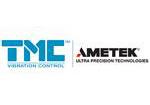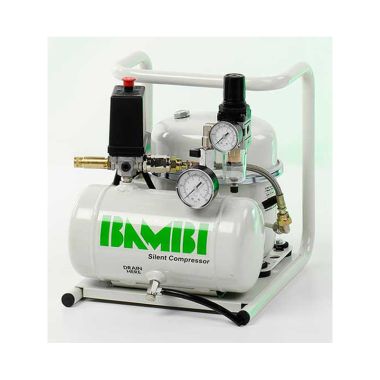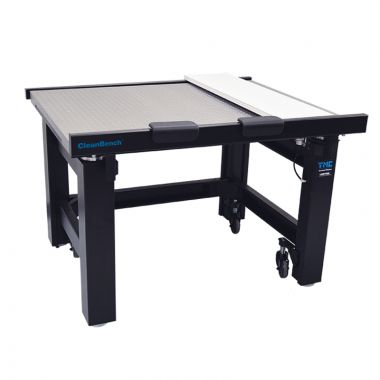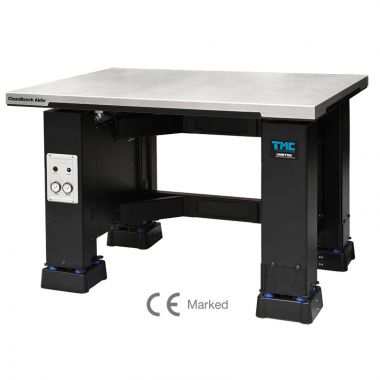TMC CleanBench High-Capacity
- Vertical and horizontal vibration isolation starting at 2 Hz
- Reduces vibration by more than 95% at 10Hz
- Virtually free of friction, avoiding rolling friction to static friction transitions
- Accommodates horizontal displacement by acting as a gimbal
For table applications that require isolating over 350 lbs (160 kg) of net load, we recommend High Capacity CleanBench 68-500 Series tables. They are similar in design to the 63-500 Series tables, with higher capacity isolators and a more massive stainless steel top plate.
In addition to high load applications, the High Capacity CleanBench is also recommended for payloads with unusually high centers of gravity and equipment with moving stages. These applications should benefit from the increased stability.
With a stiffer, more massive top plate, a lower natural frequency isolator, and stiffer, heavier leg frames, High Capacity CleanBenches provide performance that is markedly superior to any other passive table in the industry.
Gimbal Piston Vibration Isolators
All CleanBench tables incorporate TMC’s Gimbal Piston Air Isolators as a standard feature. The Gimbal Piston has consistently shown to out-perform other air isolators in side-by-side testing. It offers outstanding low frequency vibration isolation in all axes and maintains its performance specifications even when subjected to extremely low input levels of excitation. Proprietary damping techniques allow the Gimbal Piston to stabilize relatively top-heavy payloads and quickly dissipate disturbances of the isolated table top.
The Gimbal Piston® Air Isolator provides outstanding isolation in all directions for even the lowest input levels. It is lightly damped and highly responsive to typical, low-amplitude ambient floor vibrations, yet achieves very high damping for gross transient disturbances, such as sudden load changes or bumping the top plate. The result is that Gimbal Piston Isolators provide superior isolation yet will virtually eliminate any gross disturbance within a few seconds. It can also stabilize isolated systems with relatively high centers of gravity without compromising isolation.
Limitations of Other Types of Isolators:
Thick- Wall Rubber Diaphragms. Most commercial isolators employ an inexpensive, thick-walled rubber diaphragm in the piston to achieve vertical isolation. Because of the relative inflexibility of these elements, low amplitude vibration isolation performance is compromised. Though such a system feels “soft” to gross hand pressure, typical low-level floor vibration causes the rubber to act more like a rigid coupling than a flexible isolator.
Sealed Pneumatic Isolators (Passive). Sealed air isolators do not automatically adjust to load changes. The primary limitation of such systems is that they must be made too stiff to be effective isolators. For example, a passive isolator with a true 1.5 Hz resonant frequency would drift several inches vertically in response to small changes in load, temperature, or pressure and require constant manual adjustment. Thus, no practical sealed isolators are designed with such low resonant frequencies.
Bearing Slip Plates. In theory, bearing slip plates should allow horizontal isolation by their decoupling effect. In practice, for such a design to work at low amplitudes, it would require precision ground, hardened bearings with impossibly small tolerances. The commercially available versions cannot overcome the static frictional forces at low amplitudes to get the bearings rolling at all. In addition, all such systems are difficult to align initially and easily drift out of calibration.
Homemade Assemblies. Homemade isolation systems - often a steel or granite slab placed on rubber pads, tennis balls, or air bladders - will work only if the disturbing vibrations are high frequency and minimal isolation is required. While all isolators use the principle of placing a mass on a damped spring, their performance is differentiated primarily by spring stiffness: the stiffer the spring, the higher the resonant frequency. Thus, homemade solutions are limited by their high resonant frequency.
A Gimbal Piston™ Isolator with a 1.5 Hz vertical resonant frequency begins to isolate at 2 Hz and can reduce vibration by over 95% at 10 Hz. A tennis ball under a steel plate with a 7 Hz resonant frequency begins to isolate above 10 Hz and reduces vibrations by 90% at 30 Hz. But most building floors exhibit their highest vibrational displacements between 5 and 30 Hz, so that a tennis ball or rubber pad actually makes the problem worse by amplifying ambient frequencies between 5 and 10 Hz.
Key Specifications
| Isolator Natural Frequency | High Input: 1.0 Hz vertical; 0.8 Hz horizontal Low Input: 1.7 Hz vertical; 1.5 Hz horizontal |
| Isolator Efficiency @ 5 Hz | 80-90% vertical and horizontal |
| Isolator Efficiency @ 10 Hz | 90-99% vertical and horizontal |
| Recommended Payload | 1,200 lbs. (545 kg) |
| Finish | Medium texture black powder coat frame and stainless steel top |
| Facilities Requirements | 80 psi (5.5 bar) nitrogen or air |
We have no downloads available for this product.











